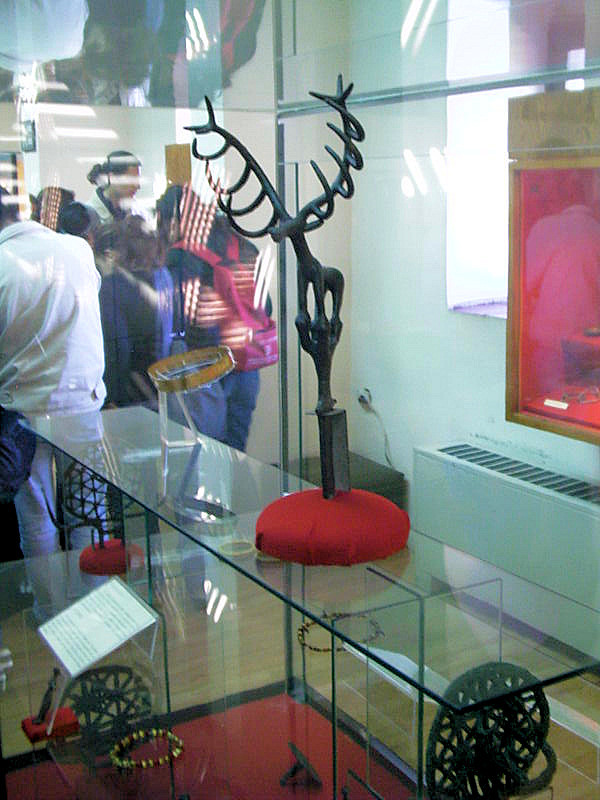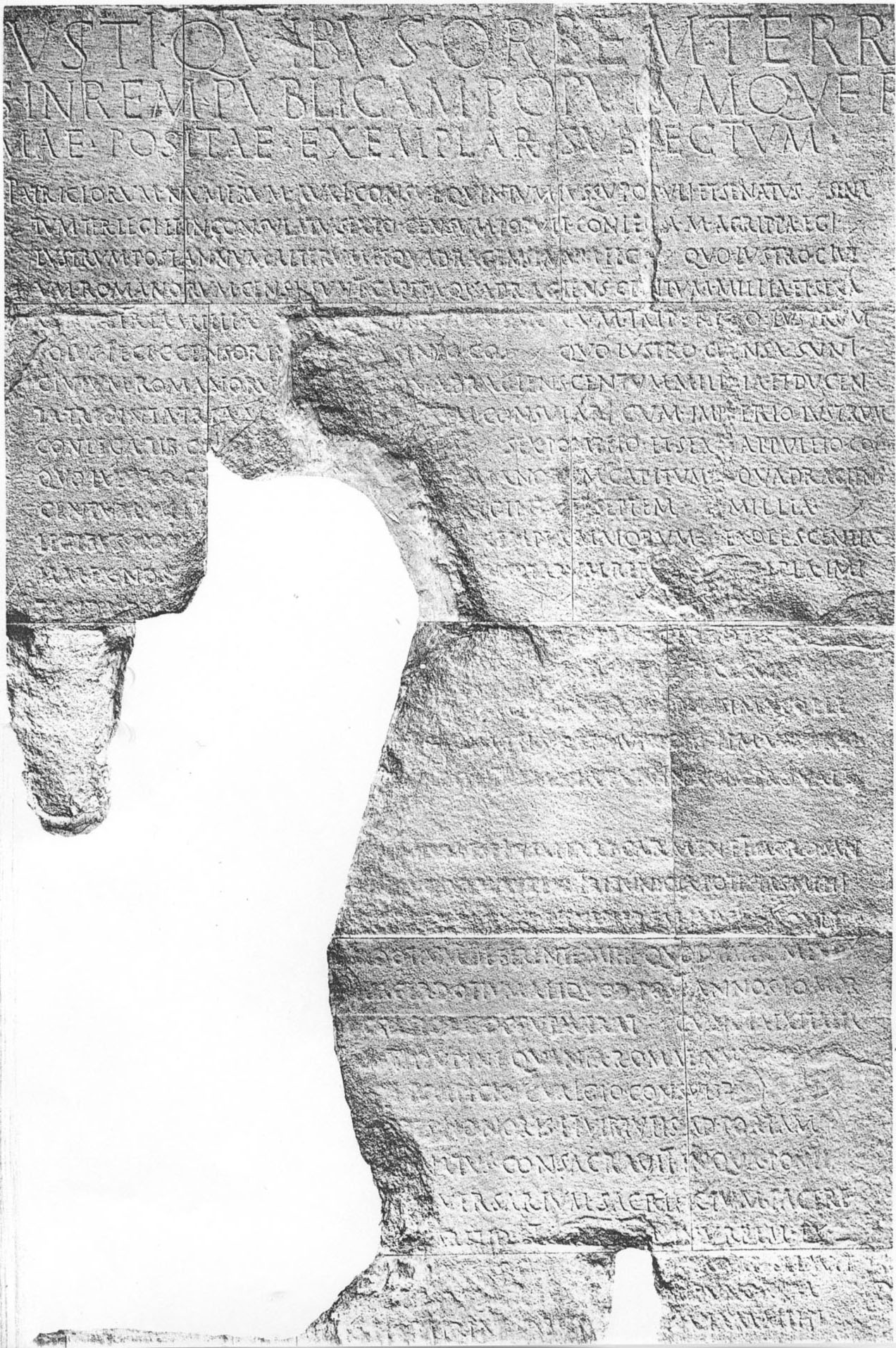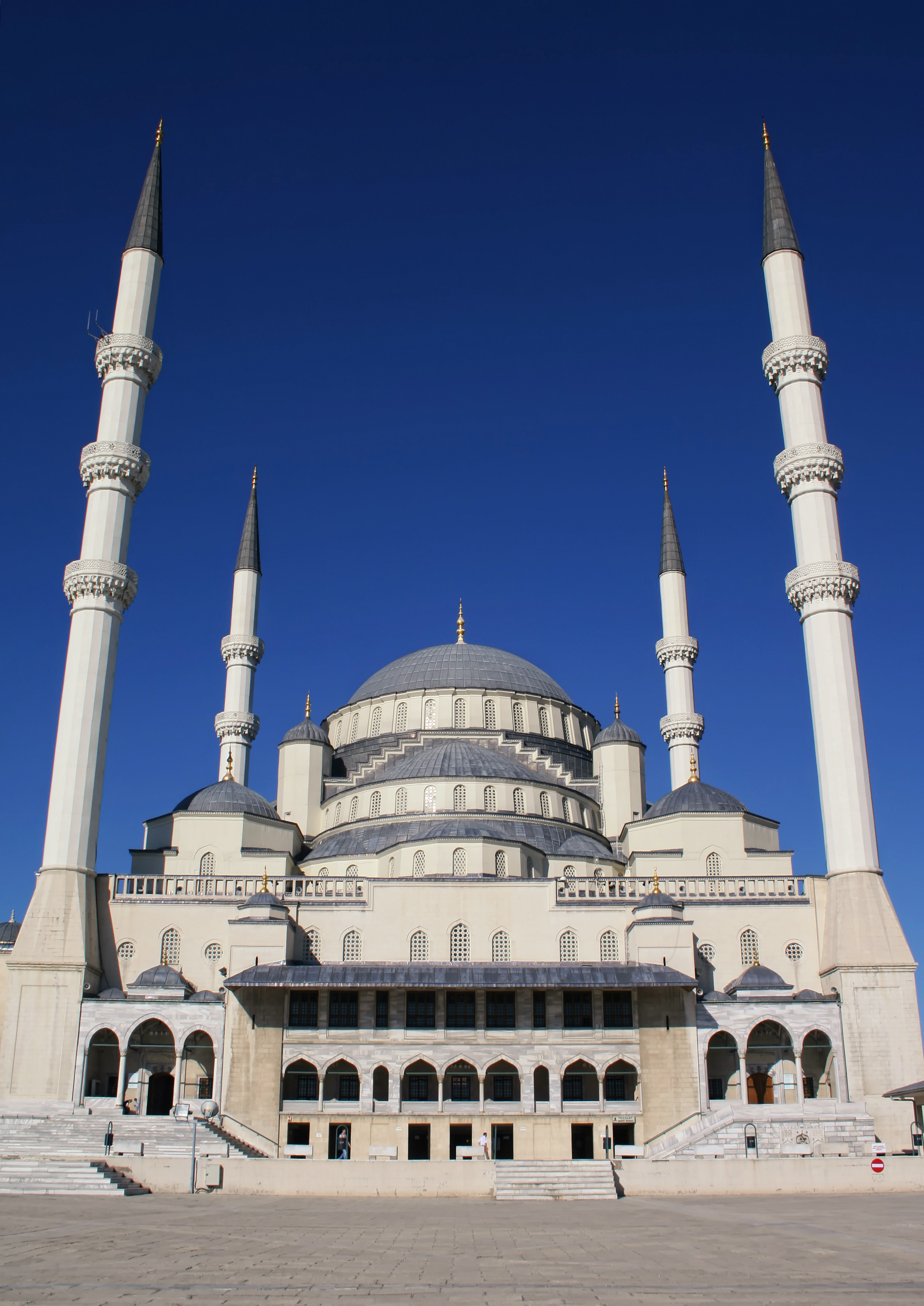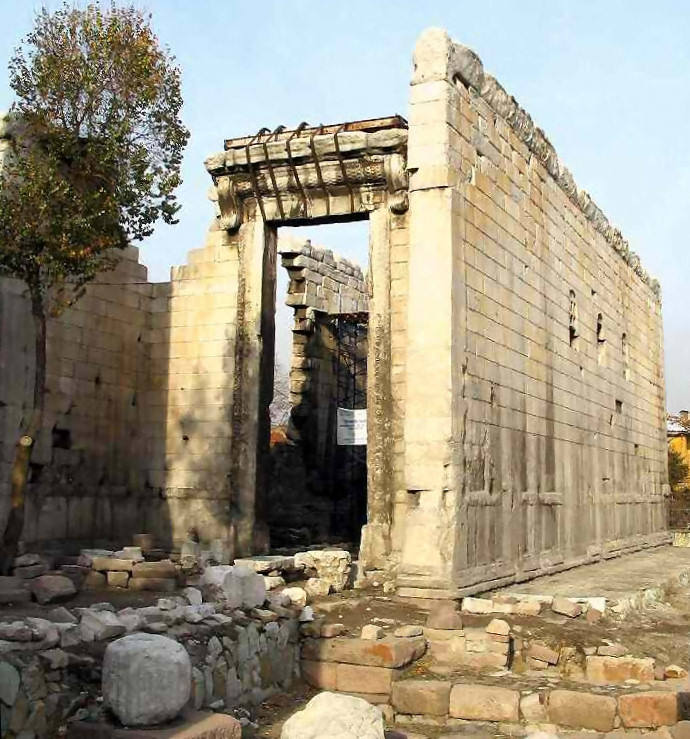
Hittite artifacts on display at the Museum of Anatolian Civilizations, Ankara
Ankara is the capital of Turkey and the country's second largest city after Istanbul. The city has a mean elevation of 938 metres (3,077 ft), and as of 2010 the metropolitan area in the entire Ankara Province had a population of 4.4 million.

The Dying Gaul was a famous statue commissioned in some time between 230 BC and 220 BC by King Attalos I of Pergamon to honor his victory over the Celtic Galatians in Anatolia. Roman marble copy of a Hellenistic work of the late third century BCE. Capitoline Museums, Rome.
As with many ancient cities, Ankara has gone by several names over the ages. It has been identified with the Hittite cult center Ankuwaš, although this remains a matter of debate.[5] In classical antiquity and during the medieval period, the city was known as Ánkyra (Ἄγκυρα, "anchor") in Greek and Ancyra in Latin; the Galatian Celtic name was probably a similar variant.

The Column of Julianus, now in the Ulus district, was erected in honor of the Roman Emperor Julian the Apostate's visit to Ancyra in 362.
Following its annexation by the Seljuq Turks in 1073, the city became known in many European languages as Angora, a usage which continued until its official renaming to "Ankara" under the Turkish Postal Service Law of 1930.[6] Another proposed theory show that the original name of the city might be taken over from the Angara River of Asia by the invading Seljuk Turks.

The Res Gestae is the self-laudatory autobiography completed in 13 AD, just before his death, by the first Roman emperor Augustus. Most of the text is preserved in the Monumentum Ancyranum
Centrally located in Anatolia, Ankara is an important commercial and industrial city. It is the center of the Turkish Government, and houses all foreign embassies. It is an important crossroads of trade, strategically located at the centre of Turkey's highway and railway networks, and serves as the marketing centre for the surrounding agricultural area. The city was famous for its long-haired Angora goat and its prized wool (mohair), a unique breed of cat (Angora cat), white rabbits and their prized wool (Angora wool), pears, honey, and the region's muscat grapes.
The second Turkish Parliament Building (1923), which is now the Republic Museum.
The historical center of Ankara is situated upon a rocky hill, which rises 150 m (492 ft) above the plain on the left bank of the Ankara Çayı, a tributary of the Sakarya (Sangarius) river. The city is located at 39°52'30" North, 32°52' East (39°52′30″N 32°50′00″E / 39.875°N 32.8333°E / 39.875; 32.8333Coordinates: 39°52′30″N 32°50′00″E / 39.875°N 32.8333°E / 39.875; 32.8333), about 450 km (280 mi) to the southeast of Istanbul, the country's largest city.
Although situated in one of the driest places of Turkey and surrounded mostly by steppe vegetation except for the forested areas on the southern periphery, Ankara can be considered a green city in terms of green areas per inhabitant, which is 72 m2 per head.

The Grand National Assembly of Turkey
Ankara is a very old city with various Hittite, Phrygian, Hellenistic, Roman, Byzantine, and Ottoman archaeological sites. The hill which overlooks the city is crowned by the ruins of the old castle, which adds to the picturesqueness of the view, but only a few historic structures surrounding the old citadel have survived to the present day.

Ankara is famous for its local varieties of grapes and wine, such as Kalecik Karası and Kavaklıdere.
There are, however, many finely preserved remains of Hellenistic, Roman and Byzantine architecture, the most remarkable being the Temple of Augustus and Rome (20 BC) which is also known as the Monumentum Ancyranum

The planned residential apartment tower blocks are a typical feature of Ankara and of all Turkish cities and towns in general.
Main sights

Anıtkabir, Atatürk's mausoleum
Anıtkabir
is located on an imposing hill, Anıttepe quarter of the city, where the mausoleum of Mustafa Kemal Atatürk, founder of the Republic of Turkey, stands. Completed in 1953, it is an impressive fusion of ancient and modern architectural styles. An adjacent museum houses a wax statue of Atatürk, his writings, letters and personal items, as well as an exhibition of photographs recording important moments in his life and during the establishment of the Republic. Anıtkabir is open every day, while the adjacent museum is open every day except Mondays.
Museum of Anatolian Civilizations (1921).
Ankara Ethnography Museum (Etnoğrafya Müzesi)
This museum is opposite the Opera House on Talat Paşa Boulevard, in the Ulus district. There is a fine collection of folkloric as well as Seljuq- and Ottoman-era artifacts.

A Hattian artifact,from the 3rd millennium BC, in the Museum of Anatolian Civilizations.
Museum of Anatolian Civilizations (Anadolu Medeniyetleri Müzesi)
Situated at the entrance of Ankara Castle, it is an old "bedesten" (covered bazaar) that has been beautifully restored and now houses a unique collection of Paleolithic, Neolithic, Hatti, Hittite, Phrygian, Urartian, and Roman works as well as a major section dedicated to Lydian treasures.
The Türkocağı Building (1927), which houses the Operet Sahnesi and the State Art and Sculpture Museum.
State Art and Sculpture Museum (Resim-Heykel Müzesi)
This museum is close to the Ethnography Museum and houses a rich collection of Turkish art from the late 19th century to the present day. There are also galleries which host guest exhibitions.

Kocatepe Mosque (1989).
Cer Modern
is the modern-arts museum of Ankara inaugurated in 01 April 2010. It is situated in the renovated building of the historic TCDD Cer Atölyeleri, the workshop of the Turkish National Railways. The museum incorporates the largest exhibition hall in Turkey. The museum holds periodic exhibitions of modern and contemporary art as well as hosting other contemporary arts events.

Çankaya Köşkü (1932) is the residence of the President of Turkey.
War of Independence Museum (Kurtuluş Savaşı Müzesi)
This building, located on Ulus Square, was originally the first Parliament building (TBMM) of the Republic of Turkey. The War of Independence was planned and directed here as recorded in various photographs and items presently on exhibition. In another display, wax figures of former presidents of the Republic of Turkey are on exhibit.
TCDD Open Air Steam Locomotive Museum - An open-air museum which traces the history of steam locomotives.

Hatti Monument (1970), on Sıhhiye Square. It was the city's official logo.
Çengelhan Rahmi Koç Museum
is a museum of industrial technology situated in Çengelhan, an Ottoman Era caravanserai. The exhibits include industrial/technological artifacts from 1850s onwards.

Gençlik Park (Youth Park) in central Ankara.
Ankara Aviation Museum (Hava Kuvvetleri Müzesi Komutanlığı)
The museum is near the Istanbul Road in Etimesgut. It is home to various missiles, avionics, aviation materials and aircraft that have served in the Turkish Air Force (e.g. combat aircraft such as the F-86 Sabre, F-100 Super Sabre, F-102 Delta Dagger, F-104 Starfighter, F-5 Freedom Fighter, F-4 Phantom; and cargo planes such as the Transall C-160.) Also, a Hungarian MiG-21, a Pakistani MiG-19, and a Bulgarian MiG-17 are on display in the museum.

Armada Shopping Center in Ankara was selected as "Europe's Best Shopping Mall" by the ICSC in 2003, becoming the second mall in Turkey after Akmerkez in Istanbul (Europe's Best 1995, World's Best 1996) to win this prestigious award.
METU Science and Technology Museum (ODTÜ Bilim ve Teknoloji Müzesi)
is based in the Middle East Technical University campus.
Archeological sites
Ankara Citadel walls.
Ankara Citadel
The foundations of the citadel or castle were laid by the Galatians on a prominent lava outcrop (39°56′28″N 32°51′50″E / 39.941°N 32.864°E / 39.941; 32.864), and the rest was completed by the Romans. The Byzantines and Seljuqs further made restorations and additions. The area around and inside the citadel, being the oldest part of Ankara, contains many fine examples of traditional architecture. There are also recreational areas to relax. Many restored traditional Turkish houses inside the citadel area have found new life as restaurants, serving local cuisine.
The citadel was depicted in various Turkish banknotes during 1927–1952 and 1983–1989.

Interior view of Karum Shopping & Business Center (1990).
Roman Theatre
The remains, the stage, and the backstage can be seen outside the castle. Roman statues that were found here are exhibited in the Museum of Anatolian Civilizations (see above). The seating area is still under excavation.

In the Temple of Augustus and Rome (commonly known as Monumentum Ancyranum) in Ulus, the primary intact copy of Res Gestae written by the first Roman Emperor Augustus survives.
Temple of Augustus and Rome
The temple, also known as the Monumentum Ancyranum, was built between 25 BC - 20 BC following the conquest of Central Anatolia by the Roman Empire and the formation of the Roman province of Galatia, with Ancyra (modern Ankara) as its administrative capital. After the death of Augustus in 14 AD, a copy of the text of Res Gestae Divi Augusti was inscribed on the interior of the pronaos in Latin, whereas a Greek translation is also present on an exterior wall of the cella. The temple, on the ancient Acropolis of Ancyra, was enlarged by the Romans in the 2nd century. In the 5th century it was converted into a church by the Byzantines. It is located in the Ulus quarter of the city.
Ankara Opera House of the Turkish State Opera and Ballet (1933).
Roman Bath
This bath has all the typical features of a classical Roman bath: a frigidarium (cold room), tepidarium (warm room) and caldarium (hot room). The bath was built during the reign of Emperor Caracalla in the 3rd century AD to honour Asclepios, the God of Medicine. Today, only the basement and first floors remain. It is situated in the Ulus quarter.
The historical Evkaf Apartmanı in which the Head Office of the Turkish State Theaters is situated. The building also houses the Küçük Tiyatro and Oda Tiyatrosu.
Column of Julian
The Column of Julian or Julianus, now in the Ulus district, was erected in honor of the Roman Emperor Julian the Apostate's visit to Ancyra
 03:44
03:44
 homesweethome
homesweethome


 Posted in:
Posted in: 








0 意見:
Post a Comment